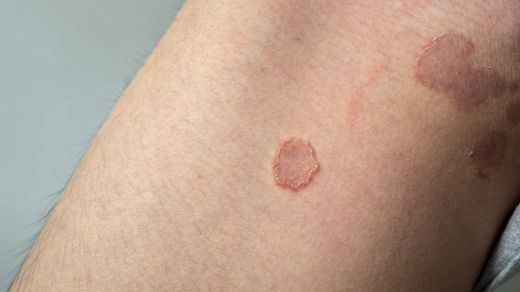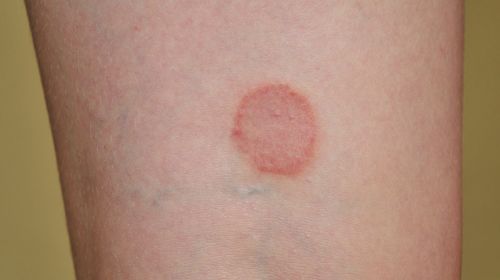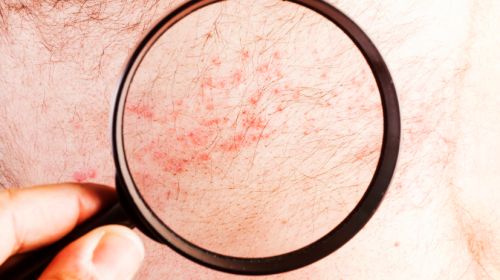Ringworm is a contagious fungal infection of the skin caused by filamentous fungi. Reddish, round skin patches with a pronounced red edge are typical of ringworm. How do you get infected and what helps against ringworm?
- © Getty Images/HengDao
Quick overview: Frequently asked questions and answers
How does ringworm start? In the early stages, reddish round spots with a darker, slightly raised edge are typical of ringworm.
How do you get ringworm? The fungal infection is transmitted through contact with infected people or animals or through objects such as towels and sports equipment.
What can you do about ringworm? Ringworm is treated with an antifungal ointment (antimycotics) or, in the case of a deeper infection, with appropriate tablets.
How long does it take for ringworm to go away? Fungal infections are stubborn: treatment should extend over several weeks to prevent ringworm from coming back.
Article contents at a glance:
What is ringworm?
Ringworm is a fungal infection (dermatomycosis) that primarily affects the skin on the torso, arms, legs and face. That’s why experts also call it “tinea corporis” (corpus = trunk, body).
Raised and reddened, sometimes scaly patches appear on the affected skin areas, which are surrounded by a darker edge. This ring gave the disease its name.
Ringworm is the most common fungal skin disease worldwide. The risk of developing it over the course of your life is 10 to 20 percent. Teenagers and young adults are most commonly affected.
Ringworm: causes and risk factors
Ringworm is caused by filamentous fungi (dermatophytes) that nest in the top layer of skin and feed on horny substance (keratin). Common pathogens include: Trichophyton rubrum or Microsporum canis. They are transmitted through direct contact with sick people or animals.
Infection with the fungi is also possible via contaminated objects or surfaces (such as sports mats, clothing or towels). The incubation period, i.e. the length of time between infection and the appearance of the first symptoms, is one to three weeks.
Some factors promote the occurrence of a fungal skin infection:
- warm and humid environment
- excessive sweating
- sharing towels and clothing
- Sports with physical contact
- airtight clothing
- other fungal diseases (such as athlete’s foot)
- Family members who suffer from ringworm
- close contact with animals
- immunodeficiency
- Diabetes mellitus
- Taking antibiotics
How contagious is ringworm?
The risk of infection is only moderately high: the probability of infection within a school class is ten percent, and within the family it is ten to 30 percent. Once treatment has begun, there is no longer any risk of infection very quickly.
Symptoms of ringworm
Typical for ringworm is a round, reddish spot with a red edge that tends to scale, is raised above the level of the skin and can itch. As the infection progresses, several of the spots may coalesce into a large, map-like area.
The rash occurs on the stomach, back, arms, legs and face, and in children and adolescents especially on the trunk.
In addition, the symptoms differ depending on the form of ringworm:
Tinea corporis superficialis: In the superficial form of ringworm, the inflammation is limited to the upper layers of the skin, so there is only a minor inflammatory reaction.
Tinea corporis profunda: The deep form of ringworm causes severe inflammation in the form of fluid-filled blisters. Other symptoms such as fever, fatigue and swollen lymph nodes may occur. The deep form of ringworm occurs primarily in the beard and neck region in men and on the forearms and hairy head in children.
Ringworm: examinations and diagnosis
Dermatologists can usually recognize ringworm based on its typical appearance. You will also find it easy to distinguish between ringworm and ringworm, which are often confused by laypeople.
In addition, a small amount of skin is often scraped off and examined under a microscope for the presence of fungi. Creating a culture in the laboratory then provides certainty.
Ringworm or ringworm: what is the difference?
Both skin diseases usually manifest themselves as reddish spots on the skin. However, while the spots of ringworm have a characteristic, delimiting ring, the arrangement of the spots of ringworm is reminiscent of rose petals. In addition, they are usually not accompanied by itching.
In contrast to ringworm, ringworm is not contagious and heals on its own after a few weeks, even without treatment.
Treatment: How is ringworm treated?
In the superficial form of ringworm, treating the rash with an ointment that works against filamentous fungi (antimycotic) is usually sufficient. The treating doctors decide on the exact dosage. However, the ointment is usually applied once or twice a day for a period of two to four weeks.
However, experts advise against self-treatment with home remedies such as apple cider vinegar.
For the deep form of ringworm, antifungal medications are prescribed in the form of tablets for a period of two to six weeks.
Course and prognosis of ringworm
In most cases, ringworm heals without any consequences after treatment with an antifungal medication. However, the treatment of skin fungi requires patience: If the therapy is not carried out consistently enough, relapses can occur.
If ringworm spreads into skin folds or moist areas of skin, it can also lead to a bacterial infection.
Prevention: How can ringworm be prevented?
The best ways to prevent ringworm are to wear loose-fitting clothing and keep your skin dry and clean. To avoid infection, you should avoid sharing towels, hairbrushes or similar utensils. Careful hygiene is required with sports mats.
Infected people and animals should be treated as quickly as possible to prevent spread. In the event of epidemics in daycare centers or schools, all children should be examined and treated accordingly.


